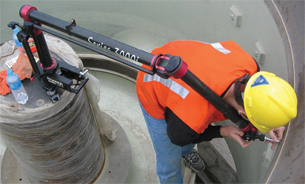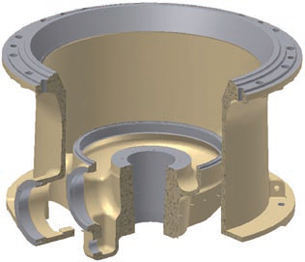Excel Foundry Forges Ahead, 1 in a Series
Expanding revenues and markets by combining scan-to-CAD software from ReverseEngineering.com with a portable Romer arm.
Latest News
February 2, 2009
By Christiann Moore
Page 1 | 2 »
 Excel Foundry and Machine expanded its market by combining a Romer Cimcore 3000i portable measurement machine with scan-to-CAD software from ReverseEngineering.com. |
Facing fierce competition, Illinois-based Excel Foundry & Machine — a manufacturer of replacement parts for mining and rock-crushing equipment — decided to expand rather than stay in place. Discarding its manual processes, Excel deployed CAD-integrated 3D software from ReverseEngineering.com (formerly HighRES) to operate more efficiently and develop new lines of business. The result: More revenue, more customers, and a brighter future.
For more than 75 years, Excel has operated under high standards of quality, precision, professionalism, and integrity, manufacturing some of the biggest and most demanding parts for the mining industry and other heavy industries, including crusher parts, mining equipment parts, and original equipment for manufacturers. The parts Excel manufactures go into cone crushers, hydraulic shovels, electric shovels, rope shovels, excavators, mining drills, and drag lines.
The Decision to Move Forward
A little more than three years ago, Excel Foundry & Machine faced a dilemma. It could continue with its proven but manual processes — measuring replacement parts in the field, for example, with calipers and other manual instruments — or it could modernize by purchasing a portable coordinate measuring machine (PCMM).
 Excel’s new solution takes the digitized point cloud and converts it into an Inventor solid model. |
Trouble was, the engineers knew the PCMM alone would not give the company the competitive advantage it needed. It was clear that the PCMM hardware needed software that would enable it to deliver its measurement data into the company’s CAD system easily, quickly, and accurately. That’s when it found the La Jolla, CA-based company called HighRES, now known as ReverseEngineering.com.
“We needed to venture off into more complex parts and systems and in doing so it’s rather difficult to get all the dimensions you need with the old hand tools,” explained Chris DeWitt, senior design engineer for Excel Foundry & Machine.
Integration, Accuracy … Profits
After looking at the PCMM-to-CAD software available on the market, Excel settled on a solution provided by ReverseEngineering.com. “We looked at a couple other companies but none of the competition’s software was nearly as robust as ReverseEngineering.com’s — not nearly as integrated into our CAD package,” said Dewitt.
 Because the new system translated directly to Inventor files, engineers were able to work in a familiar modeling environment. |
When it deployed the ReverseEngineering.com solution with its new Romer Cimcore PCMM, Excel had a fully native software bridging solution that drove data directly into its CAD system as modifiable parametric sketches. It was fully plug-and-play, absolutely integrated, operable under harsh field conditions, and easily learned and operated.
“Once we started looking at using a PCMM the clear choice for software was ReverseEngineering.com,” said Dewitt. “It was the only software we saw that could be 100 percent integrated into our modeling system.”
The Results: A True Competitive Advantage
Thanks to the direct-to-CAD qualities of the ReverseEngineering.com software, Excel Foundry has opened up new lines of business that have delivered new revenues to the company. The combination of the software with the PCMM enabled Excel to create parts fater, which in turn meant it was more likely to take on large, complex jobs.
The company has also enjoyed unprecedented flexibility, integration, accuracy, and dependability from its PCMM and software. Being able to work directly inside of its current 3D modeling application was extremely important because it allowed the company to use software its engineers were already familiar with. Any of the other programs the company investigated would have meant a significant learning curve on a new software platform and then would have required translation software to import data into its 3D modeling application before even being able to create a model.
Page 1 | 2 »
Subscribe to our FREE magazine, FREE email newsletters or both!
Latest News
About the Author
DE’s editors contribute news and new product announcements to Digital Engineering.
Press releases may be sent to them via [email protected].






